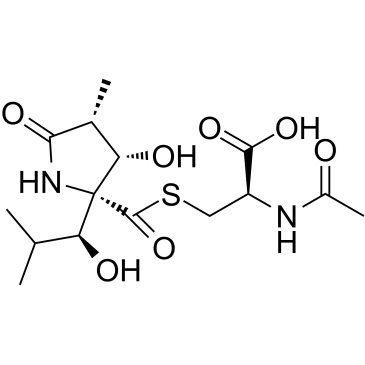乳胞素

乳胞素结构式

|
常用名 | 乳胞素 | 英文名 | Lactacystin |
|---|---|---|---|---|
| CAS号 | 133343-34-7 | 分子量 | 376.425 | |
| 密度 | 1.4±0.1 g/cm3 | 沸点 | 714.9±60.0 °C at 760 mmHg | |
| 分子式 | C15H24N2O7S | 熔点 | 233-235ºC dec. | |
| MSDS | 中文版 美版 | 闪点 | 386.1±32.9 °C |
|
Neuroprotective effect of modified Chungsimyeolda-tang, a traditional Korean herbal formula, via autophagy induction in models of Parkinson's disease.
J. Ethnopharmacol. 159 , 93-101, (2014) Previous studies in our laboratory revealed the neuroprotective effect of modified Yeoldahanso-tang (MYH) in models of Parkinson׳s disease (PD). In this study, we investigated another traditional Korean herbal formula, modified Chungsimyeolda-tang (termed DG)... |
|
|
Septins arrange F-actin-containing fibers on the Chlamydia trachomatis inclusion and are required for normal release of the inclusion by extrusion.
MBio 5(5) , e01802-14, (2014) Chlamydia trachomatis is an obligate intracellular human pathogen that grows inside a membranous, cytosolic vacuole termed an inclusion. Septins are a group of 13 GTP-binding proteins that assemble into oligomeric complexes and that can form higher-order fila... |
|
|
Development of two novel high-throughput assays to quantify ubiquitylated proteins in cell lysates: application to screening of new anti-malarials.
Malaria Journal 14 , 200, (2015) The ubiquitin proteasome system (UPS) is one of the main proteolytical pathways in eukaryotic cells and plays an essential role in key cellular processes such as cell cycle, stress response, signal transduction, and transcriptional regulation. Many components... |
|
|
Autophagy modulates amino acid signaling network in myotubes: differential effects on mTORC1 pathway and the integrated stress response.
FASEB J. 29(2) , 394-407, (2015) Induction of autophagy and the integrated stress response is important for amino acid homeostasis. It remains unknown whether the autophagy coregulates both mechanistic target of rapamycin complex 1 (mTORC1) signaling and the integrated stress response. In mo... |
|
|
Signal transduction and downregulation of C-MET in HGF stimulated low and highly metastatic human osteosarcoma cells.
Biochem. Biophys. Res. Commun. 464 , 1222-7, (2015) The poor outcome of osteosarcoma (OS), particularly in patients with metastatic disease and a five-year survival rate of only 20%, asks for more effective therapeutic strategies targeting malignancy-promoting mechanisms. Dysregulation of C-MET, its ligand hep... |
|
|
Transplantation of heterospheroids of islet cells and mesenchymal stem cells for effective angiogenesis and antiapoptosis.
Tissue Eng. Part A 21(5-6) , 1024-35, (2015) Although islet transplantation has been suggested as an alternative therapy for type 1 diabetes, there are efficiency concerns that are attributed to poor engraftment of transplanted islets. Hypoxic condition and delayed vasculogenesis induce necrosis and apo... |
|
|
CXCR4 and PTEN are involved in the anti-metastatic regulation of anethole in DU145 prostate cancer cells.
Biochem. Biophys. Res. Commun. 447(4) , 557-62, (2014) Anethole has been known to have chemopreventive activities as a suppressor of the incidence and multiplicity of both invasive and noninvasive carcinomas. The goal of this study was to understand the anti-metastatic effect of anethole through C-X-C chemokine r... |
|
|
Necrosis- and apoptosis-related Met cleavages have divergent functional consequences.
Cell Death Dis. 6 , e1769, (2015) Upon activation by its ligand hepatocyte growth factor/scatter factor, the receptor tyrosine kinase Met promotes survival, proliferation, and migration of epithelial cells during embryogenesis. Deregulated Met signaling can also promote cancer progression and... |
|
|
TCF4 Is a Molecular Target of Resveratrol in the Prevention of Colorectal Cancer.
Int. J. Mol. Sci. 16 , 10411-25, (2015) The Wnt/β-catenin pathway plays an essential role in the tumorigenesis of colorectal cancer. T-cell factor-4 (TCF4) is a member of the TCF/LEF (lymphoid enhancer factor) family of transcription factors, and dysregulation of β-catenin is decisive for the initi... |
|
|
Equine Herpesvirus 1 Multiply Inserted Transmembrane Protein pUL43 Cooperates with pUL56 in Downregulation of Cell Surface Major Histocompatibility Complex Class I.
J. Virol. 89 , 6251-63, (2015) Herpesviruses have evolved an array of strategies to counteract antigen presentation by major histocompatibility complex class I (MHC-I). Previously, we identified pUL56 of equine herpesvirus 1 (EHV-1) as one major determinant of the downregulation of cell su... |